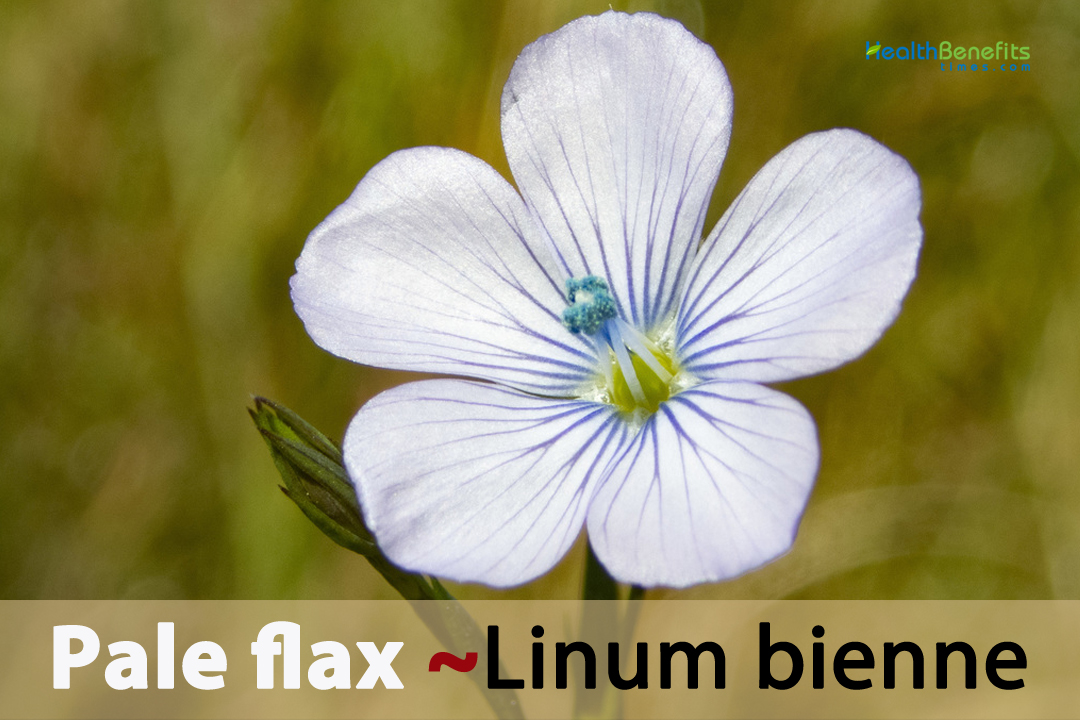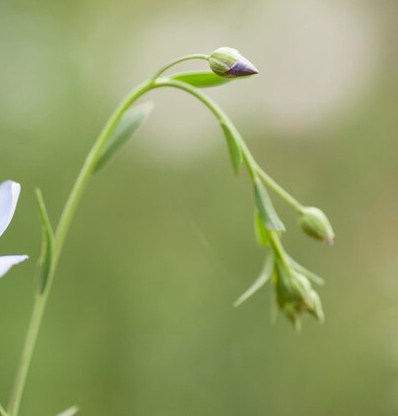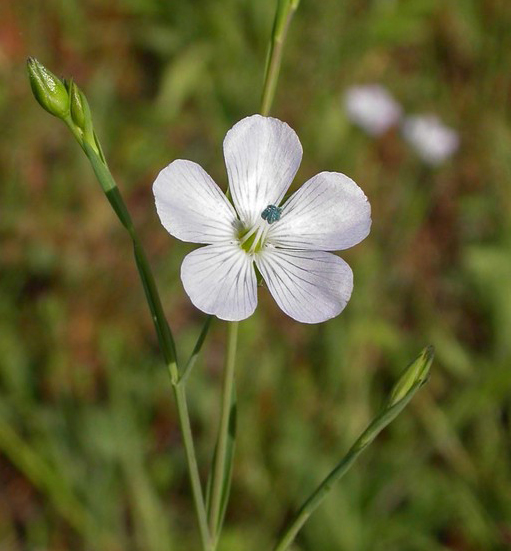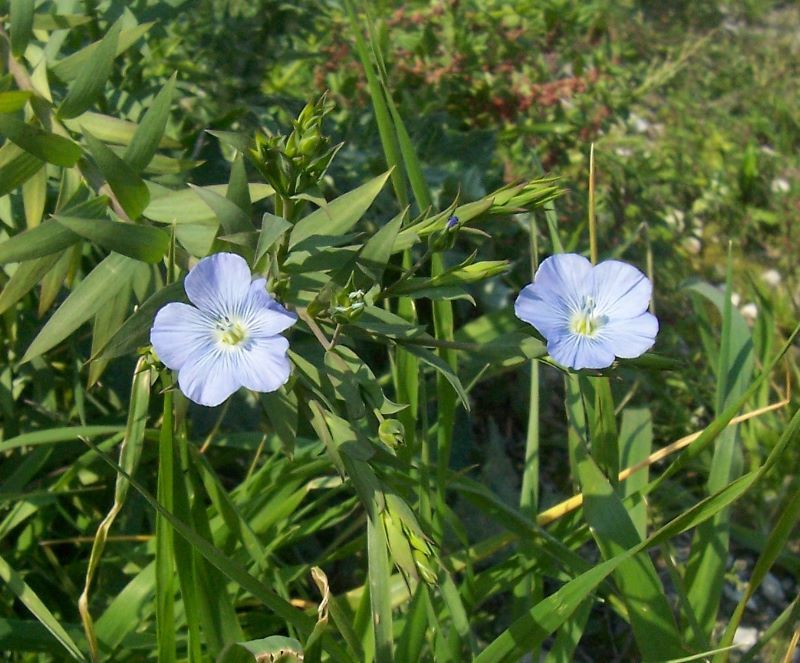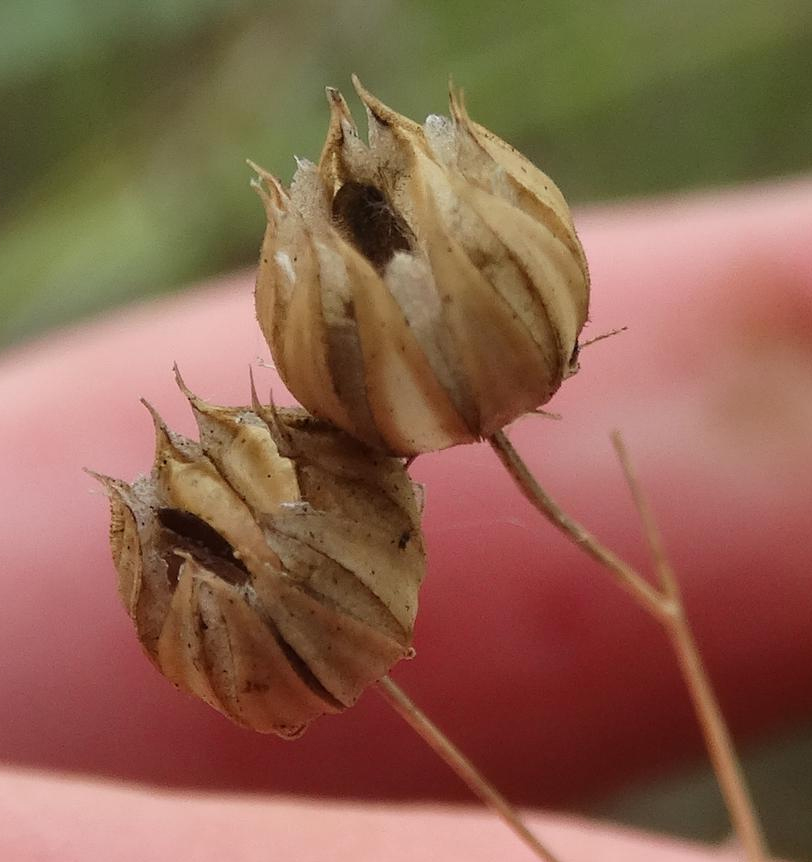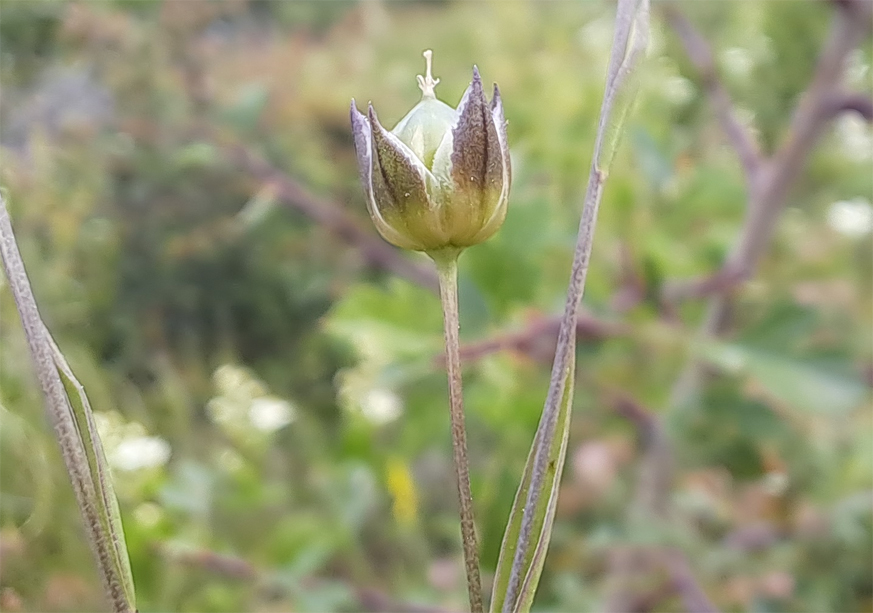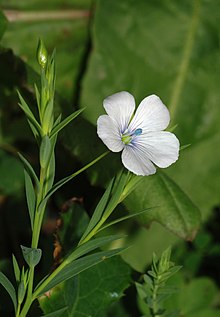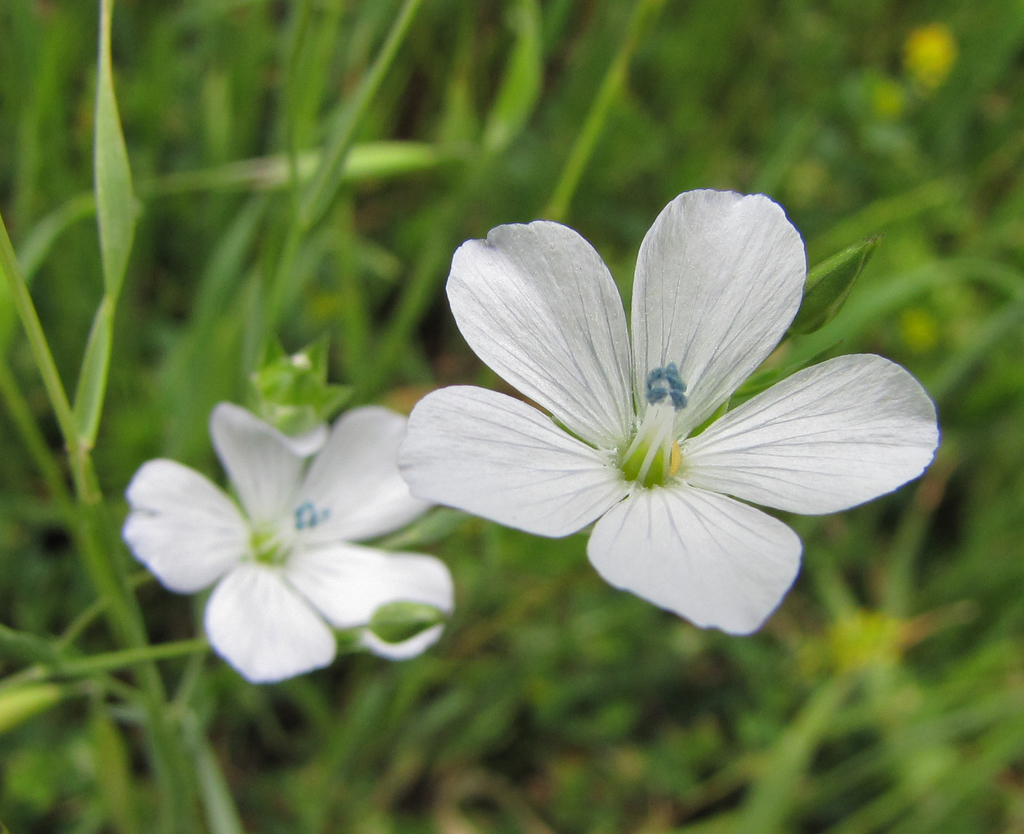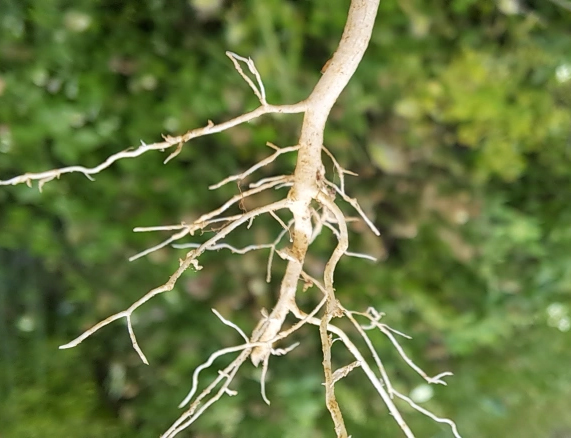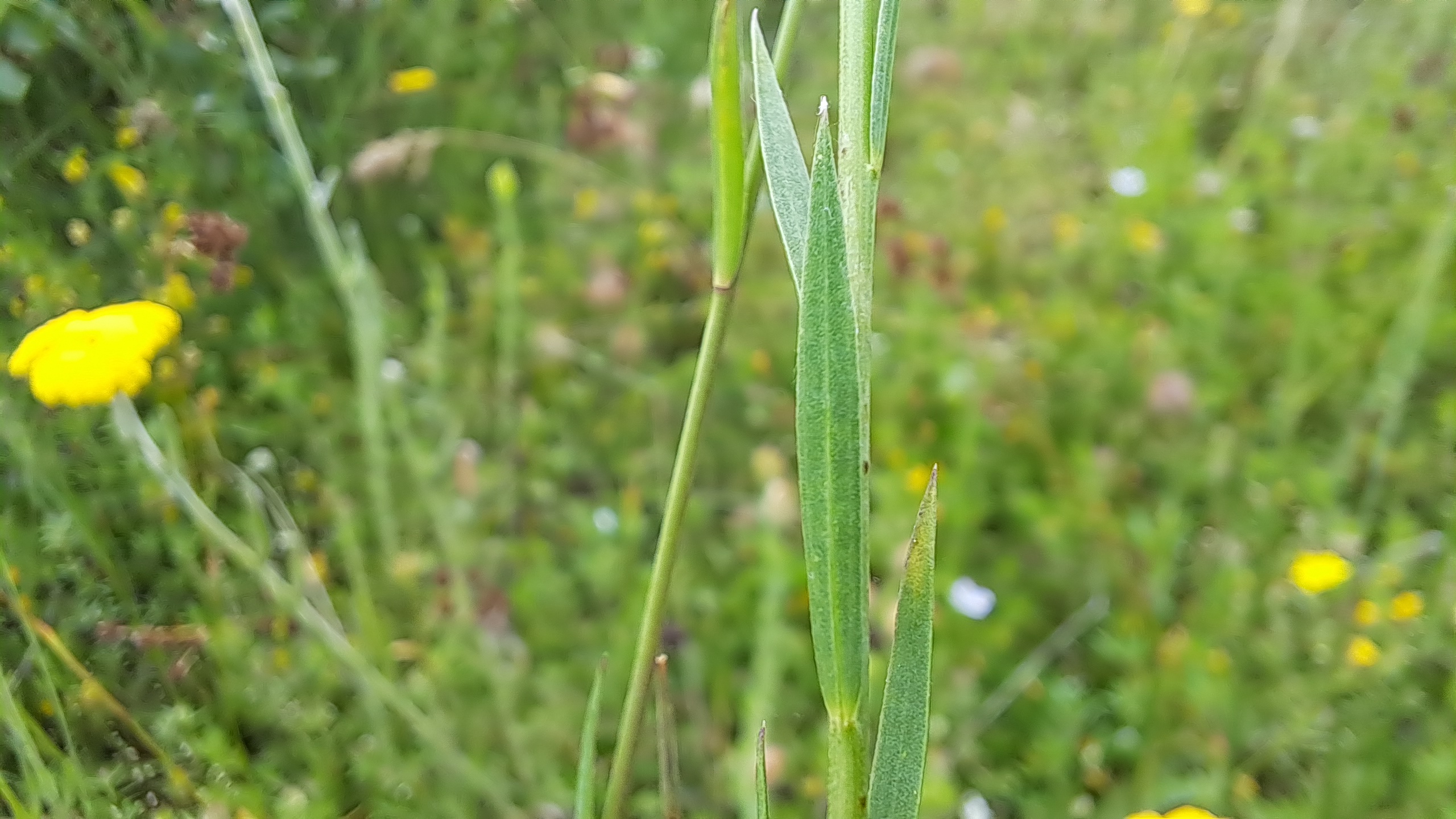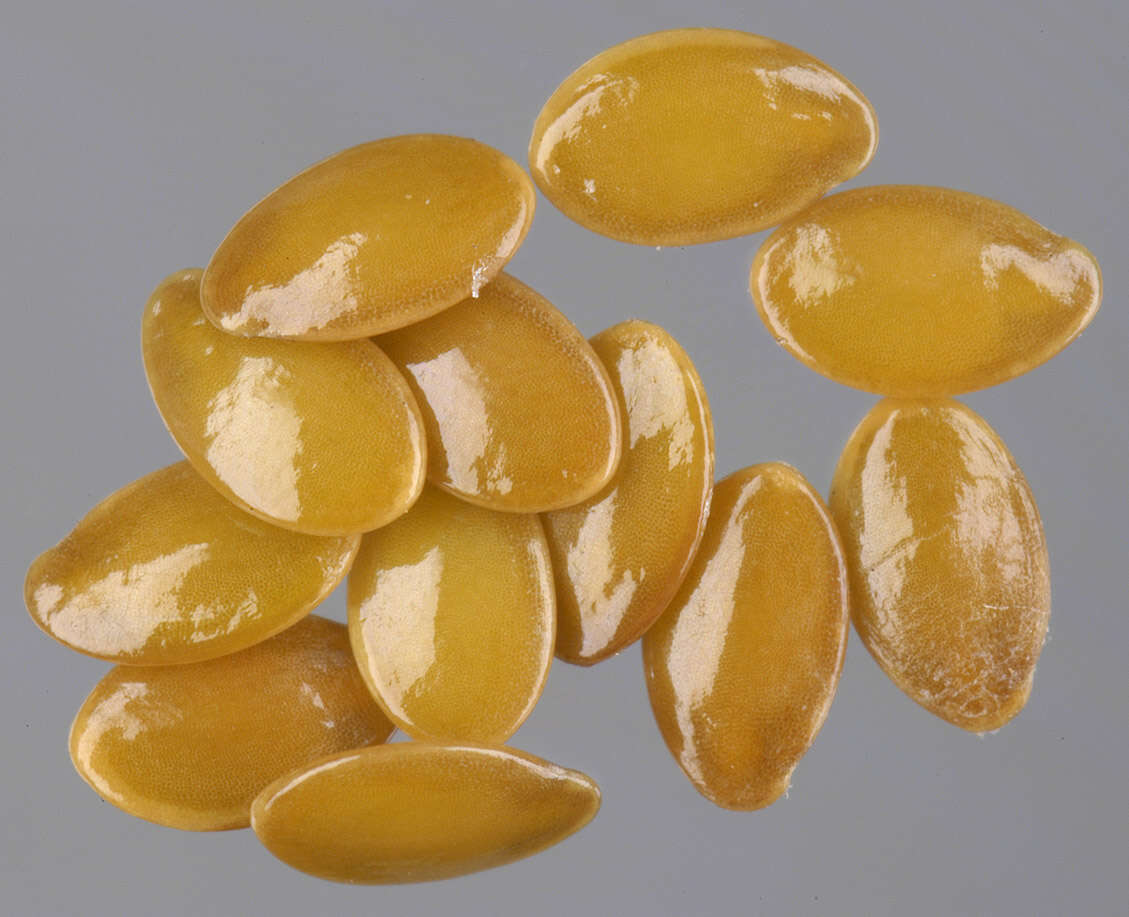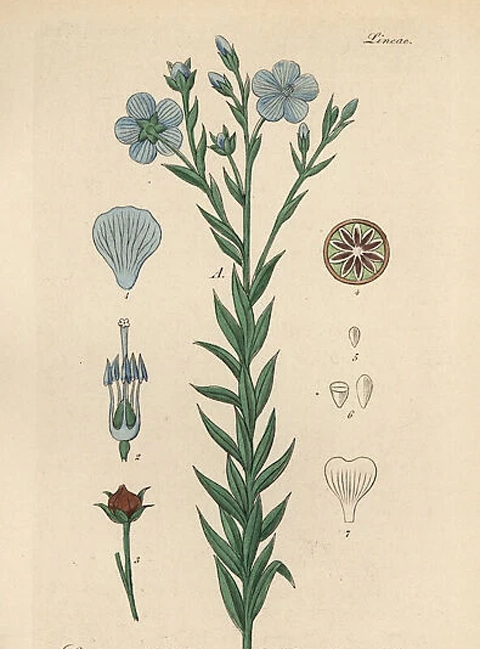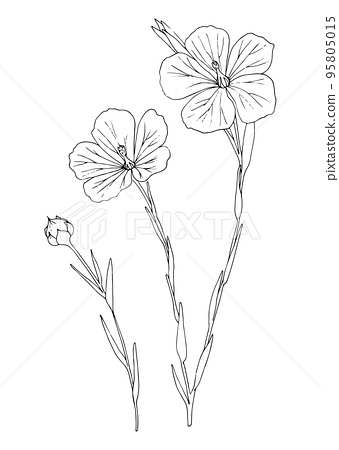| Pale flax Quick Facts | |
|---|---|
| Name: | Pale flax |
| Scientific Name: | Linum bienne |
| Origin | Mediterranean region and western Europe, Western Asia, north to England and Ireland |
| Shapes | Dry, dehiscent capsule that is relatively small and elongated |
| Taste | Slightly sweet and nutty, with a hint of earthiness |
| Major nutrients | • Dietary fiber • Healthy Fats • Proteins • Lignans • Vitamin & Minerals • Antioxidant • Water Soluble fiber • Phytosterols |
| Health benefits | Heart Health, Cholesterol Management, Digestive Health, Blood Sugar Regulation, Weight Management, Cancer Prevention, Bone Health, Skin and Hair Health, Improved Mood and Cognitive Function, Brain Health, High in Dietary Fiber |
| Name | Pale flax |
|---|---|
| Scientific Name | Linum bienne |
| Native | Mediterranean region and western Europe, Western Asia, north to England and Ireland |
| Common Names | Common Flax, White Linen Flax, Common Linen Flax, Fiber Flax, Spinning Flax, Oilseed Linseed, Cool-season Flax, Yellowseed Flax Flax Lily, Linen Plant, Lint Flax, Linseed, Golden Flax, Brown Flax, Blue Flax, Flaxseed, Oilseed Flax, Yellow Flax, Cultivated Flax, True Flax, Common Linseed, White Flax, Fine Flax, Soft Flax, Linseed Flax, Flax Plant, Flax Flower |
| Name in Other Languages | Albanian: Lisi i ëmbël, Lëndë e bardhë, Li Arabic: Katān faith (كتان فاتح), Katān fātih allawn (كتان فاتح اللون), Katān shāhib (كتان شاحب), Fîtâs Armenian: Chanch shun (Ճանճ շուն) Assamese: Pēla Phlēks (পেল ফ্ল্যাক্স) Azerbaijani: Solğun keten Basque: Lino zuria Bengali: Pēla Phlēks (পেল ফ্ল্যাক্স) Bhili: Biḷī ākoḍ (બિળી આકોડ) Bodo: Pēl Phlēks (पेल फ्लैक्स) Bosnian: Blijedi lan Bulgarian: Bled len (Блед лен), zimen len (зимен лен), dvugodishen len (двугодишен лен) Catalan: Lli blanc, lli bord, lli de prat, Chinese: Dàn yàmá (淡亚麻), Zhai ye ya ma Croatian: Blijed lan, uskolisni lan Czech: Bledý len Danish: Bleg hør Dogri: Sunn ālsī (ਸੁੰਨ ਆਲਸੀ) Dutch: Bleek vlas, Tweejarig vlas, smalbladig vlas English: Pale flax, Pale-flowered flax, narrow-leaved flax Estonian: Kahvatu lina, Hele lina Faroese: Bleikt lin Finnish: Vaalea pellava, Talvipellava French: Lin pâle, Lin cultivé, Lin bisannuel, Lin à feuilles étroites, Lin sauvage Galician: Liño pálido Garhwali: Gevata (गेवता) Garo: Simila akud (ಸಿಮಿಲಾ ಅಕುದ್) Georgian: Ghamiani lini (ღამიანი ლინი) German: Blasses Lein, Wild-Lein, Zweijähriger Lein, Wilder Lein, schmalblättriger Lein, Gondi: Kidama (किडमा) Greek: Levkokýanthi (Λευκοκυάνθι), Levkó linárion (Λευκό λινάριον), Achnó linári (Αχνό λινάρι) Gujarati: Pēl Flēks (પેલ ફ્લેક્સ), Pēla aḷasī (પેલ અળસી) Hebrew: Pishtan kahé (פשתן כהה), Pisht chay (פשת חי), pishtah tzarat-‘alim Hindi: Halka paash (हल्का पाष), Halka pila alasi (हल्का पीला अलसी), Phail Flax (फैल फ्लैक्स) Hungarian: Világos len Icelandic: Bleikt línan Irish: Lín bán Italian: Lino pallido, Lino salvatico, Lino di montagna, lino bienne Japanese: Pēru furakkusu (ペールフラックス) Kannada: Pēl Phlāks (ಪೇಲ್ ಫ್ಲಾಕ್ಸ್), Biḷi ākale (ಬಿಳಿ ಆಕಲೆ) Kashmiri: Zanjiḅīl (زنجبیل) Kharia: Raṁv (रांव) Khasi: Jait Shaphang Kokborok: Jyak fwai (জ্যাক ফুই) Konkani: Pēl Phlēks (पेल फ्लॅक्स), Vaṭayācī kavaḷī (वटयाची कवळी) Korean: Yeonhan ama (연한 아마), Hwangsaeg ama (황색 아마) Korku: Raṁv (रांव) Kurukh: Khuduk (खुदुक) Latin: Linum bienne Latvian: Bālais linu Lithuanian: Blyškus linas Macedonian: Bledo len (Бледо лен), Bled len (Блед лен) Maithili: Pēl Phlēks (पेल फ्लैक्स) Malayalam: Pēl Phlāks (പേൽ ഫ്ലാക്സ്), Pēl pullu (പേല് പുല്ല്) Manipuri: Pēla Phlēks (পেল ফ্ল্যাক্স), Ngaika ching-kak (ꯅꯦꯟ ꯄꯣꯝꯒꯤ) Marathi: Pēl Phlēks (पेल फ्लॅक्स), Vāṭīcyā śijalēlyā (वाटीच्या शिजलेल्या) Mizo: Siallung Montenegrin: Blijedi lan (Блиједи лан) Mundari: Kodo Kool (কোড্ডো কূল) Nagamese: Bili akora (বিলি আকৰা) Nepali: Pēl Phlyāks (पेल फ्ल्याक्स) Norwegian: Blekksprut, Bleik lin, Fleirårslin, Flerårslin Odia: Pēl Phlāks (ପେଲ ଫ୍ଲାକ୍ସ) Oriya: Haḷadi (ହଳଦି) Pawari: Jākā (जाका) Persian: کتان کمرنگ Polish: Blady len Portuguese: Linho pálido, linho-bravo, linho-da-terra, linho-do-inverno, linho-galego, linho-morisco, linho-silvestre, Punjabi: Pēl Phlēks (ਪੇਲ ਫਲੈਕਸ), Pīl ālsī (ਪੀਲ ਆਲਸੀ) Romanian: In, In sau lână Russian: Bledny len (Бледный лен), lion dvulietnij (лён двулетний) Sanskrit: Pēl Phlēks (पेल फ्लैक्स्) Santali: Hembaburu Scottish Gaelic: Lìn gheal Serbian: Bleda lan (Бледа лан) Sherpa: Smi dbwa’i bzos (སྨྲི་དབྭའི་བཟོས་) Sindhi: Pēl Phlēks (پيل فليڪس) Slovak: Bledý ľan Slovenian: Bled lan, dvoletni lan Spanish: Lino pálido, Lino blanco, Lino bravo, lino burdo, lino silvestre Swedish: Blek lin Tamil: Pēl Filāks (பேல் ஃபிளாக்ஸ்), Veḷḷai aḷi (வெள்ளை அளி) Tangkhul: Ngallo Kharang (ꯁꯣꯒ ꯃꯤꯆꯥꯂꯟ) Telugu: Pēl Phlāks (పేల్ ఫ్లాక్స్), Rakta avisamprēṣaka (రక్త అవిసంప్రేషక) Toda: Akkāḷi (அக்காலி) Tripuri: Bili ksaiu (বিলি ক্ষয়ু) Tulu: Biḷi ākoḷu (ಬಿಳಿ ಆಕೊಲು) Turkish: Soluk keten, Açık keten, Solgun keten, Yabani keten, deli keten Ukrainian: Blidyy lʹon (Блідий льон), Lʹon vuzʹkolystyy (Льон вузьколистий) Urdu: Pēl Phlēks (پیل فلیکس) Uzbek: Sovuq o’pax Warli: Piṭācyā lākācyā (पिटाच्या लाकाच्या) Welsh: Llinyn bâl, Llin Culddail, Llin Glan y Môr |
| Plant Growth Habit | Relatively small and slender, herbaceous annual or biennial plant |
| Growing Climates | Typically grows in dry grassland especially near the coast, along roadsides, open woodlands, meadows, field margins, paths, verges, old quarries, cliff-slopes, coombes and railway banks |
| Soil | Well-draining and moderately fertile. It prefers soils with a pH level ranging from slightly acidic to slightly alkaline (pH 6.0 to 7.5). Loamy soils with good organic matter content are ideal |
| Plant Size | Around 30-60 centimeters (12-24 inches) |
| Root | Primary root is typically thicker and longer than the lateral roots that develop later. As the pale flax plant continues to grow, lateral roots start to branch off from the primary root. These lateral roots extend horizontally into the surrounding soil |
| Stem | Upright, slender stem that can reach heights of 30 to 60 centimeters (12 to 24 inches). The stem is typically green, cylindrical, and mostly herbaceous, although it can become slightly woody at its base as the plant matures |
| Bark | Consists of a single layer of cells that serve as a protective barrier for the underlying tissues |
| Leaf | Leaves are generally lanceolate, elongated with smooth margins. Upper surface is typically smooth and shiny, while the lower surface may have a slightly different texture |
| Flowering season | May to September |
| Flower | Attractive, small, five-petaled flowers that are typically pale blue, but they can also be white or pinkish in color. The flowers have a delicate appearance and are borne in clusters at the ends of the stems |
| Fruit Shape & Size | Dry, dehiscent capsule that is relatively small and elongated |
| Seed | Seeds are small and typically ovoid in shape. They are relatively small, measuring a few millimeters in length and width |
| Varieties |
|
| Flavor/Aroma | Mild, earthy, and slightly nutty |
| Taste | Slightly sweet and nutty, with a hint of earthiness |
| Plant Parts Used | Seeds, oil, Leaves, Stem fiber |
| Propagation | By seed, Stem cutting |
| Lifespan | Within a single growing season |
| Season | July to October |
| Major Nutrition |
|
| Available Forms |
|
| Health benefits |
|
Plant Description
Pale flax is a grass plant that grows about 12 to 24 inches (30 to 60 centimetres) tall and is pretty thin. It can be an annual or biennial plant. It usually grows in dry grasslands near the coast, along roadsides, in open woods, meadows, field edges, paths, verges, old quarries, cliff slopes, coombes, and on the sides of railway tracks. The plant likes dirt that drains well and isn’t too fertile. Between 6.0 and 7.5 on the pH scale is the range of soils that this plant likes best. Ideal soils are loamy and have a lot of organic matter in them. Most of the time, it is not grown for farming or manufacturing. For that reason, Pale flax is often prized for its beauty and for helping local ecosystems and pollinators. It grows naturally in many places and helps keep the variety of plants and animals alive. It is often thought of as an important wildflower in natural and wildflower gardening because it looks nice and is good for the environment. The plant is thought to be the wild ancestor of the domesticated flax, and its stem can be used to make a fibre. It can be grown in gardens sometimes.
Appropriate growing environment for Pale flax
Pale flax is a wild flax species, and its growing environment typically mimics the conditions of its native habitat. To successfully cultivate pale flax, you should provide an appropriate growing environment that includes the following key factors:
- Sunlight: Pale flax does best in full sun to some shade. It needs at least six hours of direct sunshine every day. Make sure the area where you are planting gets enough sunlight for good growth.
- Soil: Pale flax should grow in dirt that drains well and isn’t too fertile. It grows best in soils that are slightly acidic to slightly basic (pH 6.0 to 7.5). Soils that are sandy and have a lot of organic matter are best. Don’t walk on wet or heavy clay grounds.
- Moisture: Once it’s established, pale flax can survive in dry conditions, but it usually does better in soil that stays wet. For good growth, plants need to be watered enough, especially during dry times. But be careful not to water too much, because being too wet can be bad for plants.
- Temperature: Pale flax can grow in a variety of temperatures, but it does best in mild to cool places. It can handle light cold, but it might not do well in places that are very hot or humid. In places where it gets hot in the summer, giving people some shade during the hottest parts of the day can be helpful.
- Spacing: When growing pale flax, make sure there is enough space between each plant to let air flow and keep it from getting too crowded. Most plants do well with about 6 to 12 inches (15 to 30 centimetres) of space between them.
- Competition: Weeds and other plants may make pale flax less likely to grow, so it’s important to keep the growing area clear of those plants. Regularly pulling weeds can help the plants grow.
- Wildflower Meadows: Pale flax grows in wildflower fields and other naturally occurring areas. You could put it in a wildflower garden or meadow with other natural wildflowers so that it can live together.
- Propagation: Pale flax can be grown from seeds. You should plant it right in the garden in early spring or late fall, based on where you live. Because they need light to grow, the seeds should be spread out on the ground and lightly pushed down.
- Maintenance: Once it’s established, pale flax usually doesn’t need much care. But deadheading (removing old flowers) can help the plant bloom continuously, and thinning may be needed every so often to keep it from getting too crowded.
Roots
Pale flax starts out as many other plants do: it has a main or taproot. As soon as the seed sprouts, the primary root comes out and is the main, center root. It goes deep into the ground and holds the plant in place. Most of the time, the main root is longer and thicker than the lateral roots that grow later. In order for the pale flax plant to keep growing, side roots begin to grow from the main root. The horizontal roots of these lateral roots go into the dirt around them. They are very important for plants to absorb water and nutrients because they go deeper into the earth and tie the plant down, making it more stable.
Root hairs are small structures that look like hairs and grow along the surface of the root system. They are in charge of taking water and important nutrients from the dirt. Root hairs make the root’s surface area much bigger, which makes it easier for the plant to take in nutrients. A special part of the plant called the root cap protects the tip of the main root. That part of the root that grows new cells is called the root cap. It protects the root as it pushes through the dirt and helps the root sense gravity and things that are in the way. Based on what they do, the root system can be split into different zones. Some of these zones are the meristematic zone (where cells divide and grow), the elongation zone (where cells get longer), and the maturity zone (where cells change and become specialized for specific tasks).
Stem
The stem of pale flax is straight and thin, and it can grow up to 60 centimetres (12 to 24 inches) tall. The stem is usually green, cylindrical, and mostly made up of herbs. As the plant grows, it can get a little woody at the base. The stem is made up of repeated parts called nodes and internodes. Nodes are places on a plant where flowers, leaves, or branches connect. The parts of the stem that are between the nodes are called internodes. Along the main trunk, pale flax can grow branches. The gap between the leaf and stem is called the leaf axil. These side branches can also grow higher up on the main stem. The way branches grow can be different on each plant.
Within the stem, vascular tubes carry water, nutrients, and carbohydrates to all parts of the plant. These groups have xylem and phloem in them. Xylem moves water and minerals from the roots to the rest of the plant, and phloem moves sugars made by photosynthesis to different parts of the plant. When the plant is fully grown, the base of the stem may look a little like wood. This woody part of the plant keeps it stable and helps it grow, especially as it gets bigger and makes flowers and seeds. The stem grows because of the apical meristem, which is at the very end of the stem. As the plant grows, it makes new cells that make the stem longer and give rise to leaves, flowers, and branches.
Bark
The epidermis is the top layer of the pale flax stem. It is made up of a single layer of cells that guard the tissues below. Trichomes are small, hair-like structures that can be found in the epidermis. They can be glandular and release substances. Under the skin, the cortex is a layer of ground tissue that makes up most of the stems inside. It has different kinds of cells, like collenchyma cells, which support, and parenchyma cells, which store nutrients. Vascular bundles are spread out all over the brain. Xylem and phloem tissues make up these bands. They move water, nutrients, and carbohydrates from one part of the plant to another.
You might find the pith in the middle of the stem. The pith is made up of plant tissue. Pith can be used to store things in some plants, but it might not be as clear in pale flax as it is in some woody plants. There may be some lignin in pale flax, especially in the lower parts of the stem, even though it is mostly grass and doesn’t go through secondary growth like woody plants do. Lignin gives the base of the stem some stiffness and a woody feel. You might find scars along the stem where leaves or branches used to be connected. These scars are left over from when the body was growing.
Leaves
The pale flax leaves usually grow in pairs along the stem. This means that there is one leaf attached at each node, and as you go up, the leaves switch which side of the plant they are attached to. Most pale flax leaves are lance-shaped, which means they are narrow and end in a point. The form of them is long and shaped like the head of a lance or spear. The tips of the leaves are smooth, which means they don’t have any teeth or serrations. Most of the time, the base of the leaf stays in place where it connects to the stem. This means the leaf doesn’t have a stalk, also called a petiole, and it ties straight to the stem.
Pale flax leaves usually have a pinnate venation, which means they have a pattern of veins. The main vein (midrib) runs down the length of the leaf. More narrow veins come off of the midrib and go out into the leaf blade. The top of pale flax leaves is usually smooth and shiny, but the bottom may have a slightly different feel to it. They come in different sizes, but most of them are only a few centimetres long. The exact size can change based on things like how old the plant is and how it’s growing. The leaves are usually bright green, which means they are healthy and busy making food. There are tiny holes on the surface of leaves called stomata that let gases like oxygen and carbon dioxide move between plants and other plants. There are special cells around these holes that control when they open and close. Stomata are very important for breathing and photosynthesis.
Flowers
The pale flax flowers are usually grouped together, and the plant makes an arrangement at the stem’s end. The cluster is made up of many flowers that bloom close to each other. Each flower has a thin stalk called a pedicel that connects it to the main stem or branchlets. The pedicel holds up the flower and raises it above the leaves so that pollinators can get to it more easily. Radial symmetry, which is also called actinomorphy, can be seen in pale flax flowers. This means that the flower can be cut in half across any plane, making a reflection. A lot of plants have radial symmetry.
Sepals make up the top whorl of flower structures. When the flower is a bud, pale flax usually has five petals that cover and protect the inside of the flower. The sepals are generally green and protect the flowers. The petals make up the next whorl inside the sepals. Most pale flax flowers have five petals. There are very thin petals that can be pale blue or white. This is how the plant got its name. The colorful petals are the part of the flower that stands out and draws insects. The male parts of a flower that reproduce are called stamens. Most pale flax flowers have five petals. Each stamen has a thread, a thin stalk, and an anther, which is the part that makes pollen. Pollen, which is needed to fertilize the female sexual organs, is released by the anthers.
The female reproductive part of the flower is the pistil. It is in the middle of the flower and usually has three parts: the stigma, the style, and the ovary. At the base of the petals of some types of flax, like pale flax, there are small water glands. These glands make nectar, which is a treat for insects that spread pollen, like bees and butterflies. One of the main jobs of the pale flax flower is to reproduce. Pollen is made by the stamens, and the ovules, which become seeds when mated, are in the pistil. Insects, especially bees, are the main species that fertilize flowers. Pollinators are drawn to the flowers’ bright petals and nectar glands. As they forage, they move pollen from one flower to another, which makes fertilization easier.
Fruits
Fruit is a dry package that opens up. Some fruits, like capsules, split open when they’re ready to let the seeds fall out. When it comes to pale flax, the seed is small and long. Dehiscence is the process by which the full capsule breaks open so that the seeds can fall out. When pale flax is grown, the shell splits along several lines, letting the seeds inside show. A lot of different types of flax have this kind of dehiscence. There are a few small, round seeds inside the full capsule. Usually, these seeds are grouped in a circle, going out from the middle of the capsule.
The main interest in pale flax flowers is in how they help reproduction, but people are also interested in the seeds. Flaxseeds, even those from pale flax, have been used in many ways in cooking and industry. They can be used to cook, bake, and make different things. They have oil, fiber, and protein.
Seeds
In general, pale flax seeds are small and oval-shaped. They’re not very big; their length and width are only a few millimeters. The exact size and form of each seed can be a little different. Pale flax seeds can be any color, but most of the time they are a light tan or brown. Some seeds may look a little darker or have color differences. The seed coat, also called testa, is the protected layer that grows around each seed. It’s thin but tough, and its job is to protect the baby inside the seed from outside influences. A small scar or mark called the hilum can be found on the seed coat. It shows where the seed was connected to the plant’s placenta or stalk while it was growing. As a way to tell them apart, it is usually more noticeable on one side of the seed. The embryo is the most important part of the seed, and it is inside the seed coat. It is made up of the tiny plant that is just starting to grow. The radicle, plumule, and cotyledons are all parts of the embryo. More often than not, flax seeds have two cotyledons.
Varieties of Pale flax
Pale flax is a wild flax species with several recognized varieties, each of which may exhibit slightly different characteristics, such as flower color, leaf shape, or habitat preferences. The specific classification of these varieties can vary based on botanical research and regional variations, but some common varieties and subspecies include:
- Linum bienne var. bienne: This is the most common type of pale flax. It has thin stems, narrow lance-shaped leaves, and pretty blue or white flowers. It lives in a lot of different places, like fields, meadows, and areas that have been disturbed.
- Linum bienne subsp. usitatissimum: Even though it’s not a variety, this is the type of pale flax that is grown in farms. It’s also called common flax or linseed (Linum usitatissimum). It is grown for its seeds, which are turned into flaxseed oil and flax fibers that are used to make clothes. Different types of common flax come in different shapes and colors, based on what they are used for.
- Linum bienne var. aristatum: This type of flax has aristate (pointed) leaf tips, and its flowers may look different from those of regular pale flax. It can be found in many European countries.
- Linum bienne var. graecum: This type of plant grows in Greece and the areas around it. The flowers and other traits may be different from one plant to the next.
- Linum bienne var. montanum: This type is usually found in hilly areas, and it may have changed to survive in these places.
- Linum bienne var. linearifolium: This type is found in parts of Europe and is known for having narrow, straight leaves.
- Linum bienne var. heteromorphum: The leaves of this type may have different shapes, and it can be found in many European countries.
Health benefits of Pale flax
Pale Flax shares many of its health benefits with its close relative, Linum usitatissimum, or Common Flax. Here are the detailed health benefits of Pale flax
1. Rich in Omega-3 Fatty Acid
ALA, a type of omega-3 fatty acid, can be found in pale flax seeds, which are one of the best plant-based sources of it. Omega-3 fatty acids are very important for heart health because they lower blood pressure, lower the risk of heart disease, and improve lipid levels.
2. Heart Health
Omega-3 fatty acids are good for your heart because they lower your risk of getting heart disease. They lower blood pressure, improve cholesterol profiles by lowering amounts of LDL (bad) cholesterol, and make it less likely that blood clots will form.
3. Cholesterol Management
Seeds can help keep cholesterol levels in check. The ALA and fiber in these seeds can bind to cholesterol in the gut and stop it from getting into the bloodstream.
4. Digestive Health
A lot of food fiber, both soluble and insoluble, can be found in seeds. This helps digestion, keeps you from getting constipated, and keeps your bowel movements normal.
5. Blood Sugar Regulation
Pale flax is good for people with diabetes or who are at risk of getting diabetes because it has soluble fibre that helps keep blood sugar levels steady. It makes it take longer for the body to absorb sugar, which stops quick jumps.
6. Weight Management
Flaxseeds have a lot of fibre and good fats that can help you feel full and satisfied. This may help you control your weight and eat fewer calories. People who are trying to control their weight may find that adding flaxseeds to their diet helps.
7. Anti-Inflammatory Properties
Like Common Flax, Pale Flax has lignans and omega-3 fatty acids that help reduce inflammation. These chemicals can lower inflammation in the body, which could help people who have inflammatory diseases.
8. Cancer Prevention
According to some studies, the lignans in flaxseeds may help protect against some types of cancer, like breast, prostate, and colon cancer. These chemicals might help stop the growth of cancer cells and lower the chance of getting cancer.
9. Bone Health
Lignans, which are found in flaxseeds, may help protect against some types of cancer, such as breast, prostate, and bowel cancer! It’s possible that these chemicals can help stop the growth of cancer cells and make it less likely that someone will get cancer.
10. Skin and Hair Health
Omega-3s and other healthy fats found in pale flax help keep skin hydrated, reduce dryness, and support a healthy complexion. They might also improve the structure of hair and stop hair loss.
11. Hormonal Balance
Like Common Flax, Pale Flax has phytoestrogens that can help keep the body’s hormone levels in check. This might help with menopause symptoms and hormonal issues.
12. Improved Mood and Cognitive Function
Pale flax has omega-3 fatty acids that are very important for brain health. They might make people feel better, remember things, and think more clearly, especially kids and older people.
13. Brain Health
Omega-3 fatty acids are very important for brain growth and function. Eating flaxseeds may be good for your brain and lower your risk of getting neurodegenerative diseases and losing your brain function as you age.
14. High in Dietary Fiber
Pale flax seeds have a lot of dietary fiber, which can help your body digest food, keep your bowels moving regularly, and keep your weight healthy by making you feel full.
Culinary uses of Pale flax
Pale flax, also known as wild flax or lint, is a plant that has been traditionally used for its fiber production rather than its culinary purposes. However, some parts of the pale flax plant can be utilized in cooking, although it’s not as common as other flax varieties like common flax. Here are a few culinary uses of pale flax:
- Edible Seeds: There are smaller pale flax seeds than regular flax seeds. People don’t eat them as often, but you can. You can add them to made goods like bread, muffins, or cookies to make them taste a little nutty and make them healthier. Flax seeds in general are a good source of fibre and omega-3 fatty acids.
- Sprouts: You can grow pale flax seeds and then use them in salads or as a garnish on different foods. Flax sprouts are good for you and give your food a fresh, crunchy taste.
- Decorative Toppings: Pale flax seeds can be added to yogurt, smoothie bowls, cereal, and other foods to make them look nicer. A splash of color and a hint of nuttiness are added by them.
- Herbal Tea: You can make green tea with pale flax leaves. It is not common to drink this tea, but it may have some mild healing qualities and can be used instead of regular teas that contain caffeine.
- Flaxseed Oil: Pale flax seeds can be cold-pressed to get flaxseed oil, just like regular flax seeds. Flaxseed oil has a lot of omega-3 fatty acids and can be added to food or used to finish salads and other meals. In order to keep it from getting bad, it should be kept in the fridge.
- Thickening Agent: To make soups, stews, and gravies thicker, ground pale flax seeds can be used. When mixed with water, they make something that looks like gel and can help make your foods thicker. This is especially helpful for people who don’t want to use cornstarch or flour as thickeners.
- Egg Substitute: When mixed with water, ground pale flax seeds can be used in place of eggs or dairy in recipes. In baking, like in muffins or pancakes, this flax “egg” can be used to hold things together and add wetness.
- Baking Ingredient: To make baked goods healthier, grind up green flax seeds and add them to the mix. In recipes for muffins, cookies, or quick breads, they can be used in place of some of the flour or some of the fat.
- Nutritional Boost: To get extra fiber, protein, and healthy fats, sprinkle ground pale flax seeds on top of yogurt, cereal, or a smoothie bowl.
- Flavor Enhancer: Some people like the nutty taste of flax seeds and may add them to salads, soups, or roasted veggies to make them taste better.
- Herbal Infusion: Like making herbal tea, you can make an herbal infusion by letting the pale flax leaves soak in hot water. You can drink this tea by itself or mix it with other herbs to make a unique herbal cocktail.
Different uses of Pale flax
Pale flax has been historically valued for its versatile uses, including not only culinary but also industrial, medicinal, and textile applications. Here are different uses of pale flax:
- Fiber Production: In the past, pale flax was mostly grown for the long, strong fibers that grow in the stem of the plant. Fabrics and other items made from linen are made from these fibers. Linen is famous for being long-lasting, breathable, and shiny. It’s used to make clothes, bed sheets, tablecloths, and other textiles.
- Oil Production: To get flaxseed oil, pale flax seeds can be pressed under cold water. Alpha-linolenic acid (ALA), which is found in large amounts in flaxseed oil, is an omega-3 fatty acid. It’s taken as an addition to your diet and used in some recipes as finishing oil or in salad dressings.
- Livestock Feed: A part of animal feed, especially for chickens and other pets can be pale flax seeds. They give the animals the fats and proteins they need to stay healthy.
- Soil Improvement: Pale flax seeds can be fed to animals, especially chickens and other pets. They keep the animals healthy by giving them fats and proteins.
- Ornamental Plant: People in some places grow pale flax as an ornamental plant because its pretty blue flowers can make gardens and fields look nice.
- Wildflower Conservation: As a natural wildflower, pale flax adds to biodiversity and can help with efforts to protect native plant species and pollinators.
- Craft and Art Projects: Pale flax’s dried stems and fibers can be used in many art and craft projects, like making paper, weaving, and flower arrangements.
- Traditional and Cultural Uses: Pale flax is important to the history and customs of some groups. It could have been used in ceremonies or traditions, or it could have been seen as a sign of beauty and purity.
- Wildlife Habitat: Pale flax can be an important part of projects that restore wildlife habitat. Bees, butterflies, and other pollinators are drawn to the plant’s flowers, and birds and small mammals eat its seeds.
- Natural Dye: The flowers and twigs of pale flax have been used to make natural dyes for many years in traditional crafts and textiles. These dyes can make different shades of blue and green, which means that more colors can be used to color fibers and clothes.
- Soil Erosion Control: It is possible to use pale flax to stop soil runoff, especially in places where it is a problem. Its deep roots help keep the earth stable and stop it from washing away.
- Companion Planting: Pale flax is sometimes used as a partner plant in farming and gardening to keep pests away and bring in good bugs. Some pests might be kept away from nearby crops, and the yard as a whole will have more species.
- Craft Materials: In addition to being used to make clothes, pale flax fibers can also be used for crafts, like making cordage, baskets, and small woven things. Craftspeople can use these fibers because they have a unique look and feel.
- Historical and Cultural Significance: Pale flax is important to the history and culture of many places. Folklore, rituals, and traditions may be linked to it, showing how important it is to the cultural history of some groups.
- Educational and Research Purposes: People also use pale flax for study and to teach. It can be studied in botany, agriculture, ethno botany, and ecology and it can teach us about how plants work and how they affect their surroundings.
- Land Restoration: Pale flax can be sown in some land reclamation and restoration projects to help fix up areas that have been damaged or disturbed and encourage the growth of native plant communities.
- Bee Forage Plant: Bees and other pollinators can get food from the pale flax flowers, which are full of juice. This helps pollinators stay healthy and helps honey be made.
- Experimental Farming: Pale flax can be grown in experimental farming or agricultural research to see how well it grows in different soils and climates, to find out about its genetic diversity, or to make new types with certain traits.
Side effect of pale flax
Pale flax is generally safe when consumed in moderate amounts as part of a balanced diet. However, like many foods and natural products, there can be some potential side effects or considerations to keep in mind:
- Gastrointestinal Distress: Going through stomach problems is a regular side effect of eating too many flaxseeds, even pale flax seeds. Because it has a lot of fibre, it can cause tummy problems like gas, bloating, diarrhea, or cramps. To help keep these signs from happening, it’s important to drink a lot of water when you eat flaxseeds.
- Laxative Effect: Because they have a lot of fibre, flaxseeds can help you go to the bathroom naturally. Some people may benefit from this to help with constipation, but too much of it could cause diarrhea or loose stools.
- Allergies: Some people may be allergic to flaxseeds, but it’s not common. Some allergic responses are hives, itching, swelling, or having trouble breathing. If you think you might be allergic to flaxseed, you should see a doctor right away.
- Interactions with Medications: Some medicines may not work as well when you eat flaxseeds, even pale flax seeds. They might make it harder for medicines to work, especially if you take them at the same time. If you are on medicine and want to add flaxseeds to your diet, you should talk to a doctor or nurse first.
- Blood-Thinning Effect: Omega-3 fatty acids, which can be found in flaxseeds, have some blood-thinning qualities. If you are already taking medicines that thin the blood, eating a lot of flaxseeds may make you more likely to bleed. Before adding flaxseeds to your diet, you should talk to your doctor, especially if you are taking medicine that thins your blood.
- Hormonal Effects: Lignans are chemicals found in flaxseeds that can have weak estrogenic effects on the body. While this may be good for some people, those with hormone-related conditions like breast cancer, uterine fibroids, or endometriosis should talk to a doctor before eating flaxseeds on a daily basis.
References:
https://www.itis.gov/servlet/SingleRpt/SingleRpt?search_topic=TSN&search_value=29233#null
https://npgsweb.ars-grin.gov/gringlobal/taxon/taxonomydetail?id=70408
https://pfaf.org/user/Plant.aspx?LatinName=Linum+bienne
https://gd.eppo.int/taxon/LIUBI
http://www.theplantlist.org/tpl1.1/record/kew-2348601
https://en.wikipedia.org/wiki/Linum_bienne
https://indiabiodiversity.org/species/show/244538
http://www.flowersofindia.net/catalog/slides/Pale%20Flax.html
https://temperate.theferns.info/plant/Linum+bienne
https://plants.usda.gov/home/plantProfile?symbol=LIBI5


